Minuteman Missile National Historical Site
A Blast from the Past
Article Date: March, 2012
Article and Photography by Mark Quasius

One of the newest units added to the National Park Service is a unique site. Normally thoughts of the National Park
Service bring to mind images of vast natural wonders, such as the Grand Canyon, Yellowstone, or Yosemite or even some of the famous historical
battlefields from the revolutionary or civil wars. Minuteman is a throwback to a more recent war - the Cold War.
The Minuteman Missile sites were famous for never having to fire a shot yet played a vital role in our nation's defense.
They served as a deterrent to global nuclear attack. Hidden away beneath the ground these sites were scattered across various areas of the United
States and were provided with a level of security heretofore never seen. About 500 of the 1,500 sites were located in South Dakota. It was a
location that was safe from Soviet submarine launched missiles and not in major populated areas, such as the east and west coasts. After the 1991
Strategic Arms Reduction Treaty (START) many of these sites were deactivated, rendered unserviceable and sealed up. However, this particular unit
was allowed to remain as a non-serviceable unit for public display.
Accessing The Site
The site is accessed via a small office facility just south of exit #131 on South Dakota's Interstate 90, which is about
75 miles east of Rapid City. Inside the office you will see a 12 minute interpretive film that brings you up to speed on the sites. The Delta-09
missile silo is located about 15 miles west at exit # 116 just to the south of the highway. You can drive there and view the site at your convenience
because it is a self-guided tour. You may also make a reservation for an underground guided tour into the command and control center, which is
located 4 miles west of the headquarters. We made sure to do both.
We were fortunate in that our command center tour was led by a former missileer, a retired Air Force Major who once was in
command of a similar control center. His personal anecdotes contributed greatly to our understanding of life below the surface. The tours are
limited in size due to the size of the elevator that takes you down underground as well as by the confined quarters of the launch control center.
We began by meeting our guide topside at the appointed time. We were let in through a chain link gate that enclosed a secure
area, bristling with antenna arrays, a helicopter pad, an armored vehicle, and underground access hatch covers. A small barracks building, which
looked much like a ranch house from a distance, housed the eight man support crew for the facility. Inside the barracks was a communications area as
well as living quarters for the guards and tech support team. After a tour of the above ground facilities we headed for the elevator that would take
us down into the hardened control center bunker.
The elevator doors opened up into a small room flanked by mechanical areas and a 3-1/2' thick blast door weighing 5 tons
that led to the control center. The entire underground facility was placed in a hardened concrete cylindrical container that was capable of
withstanding a nuclear blast. Topside personnel were allowed into the underground area but only the launch control officer and his assistant were
allowed inside the command center. The 5 ton blast door was locked from the inside for the duration of their 24 hour shift. Each control center
controlled 10 Minuteman Missiles, which were located at dispersed sites within a 20 mile radius of the command center.
|
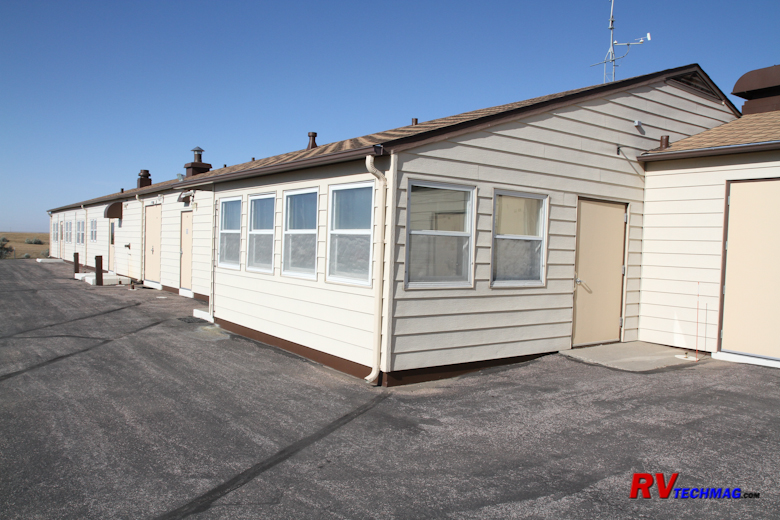
The surface structure located over the launch control center quartered the support crew and housed maintenance and communications
equipment as well as the elevator that leads to the underground launch control center.
|
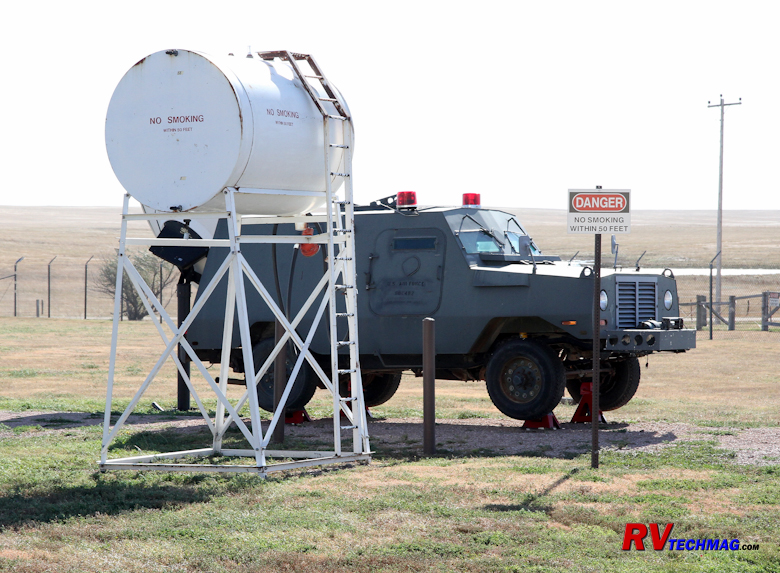
Armored security vehicles could quickly be dispatched to nearby missile silos to deal with any intrusions.
|
|
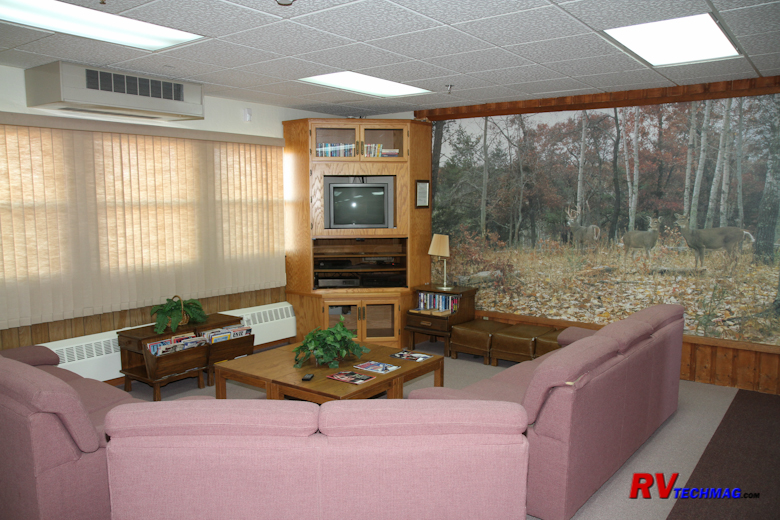
This recreation area for the topside crew helped what was described as long hours of boredom punctuated by brief minutes of shear panic.
|
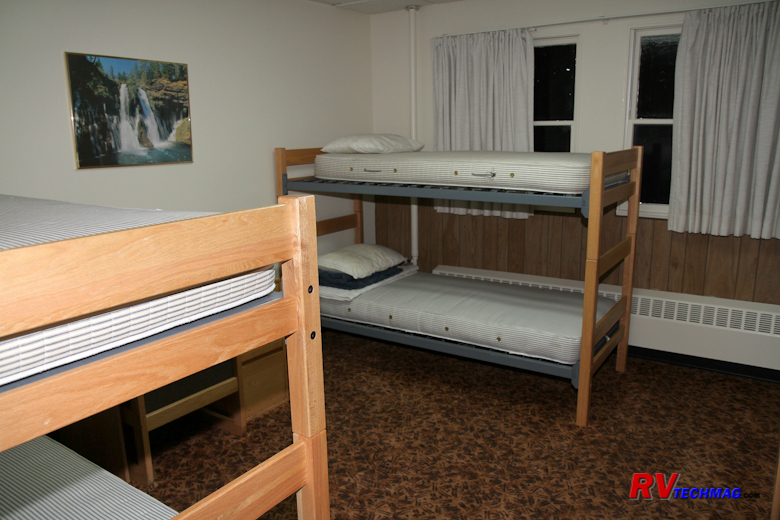
Sleeping quarters as well a kitchen, bathroom, and dining area were provided for the crew.
|
The Command Center
The shifts were described as long periods of intense boredom, punctuated by brief periods of extreme panic. Training drills
were implemented unannounced and with total surprise to keep the missileers on their toes. The topside crew was in a similar situation and found
creative things to keep busy. Air Force flight service personnel typically paint nose art on their planes but missileers don't have planes so
artwork takes form on the basement walls and on the huge blast door. In fact, the blast door at Delta-01 showed a pizza delivery box reminiscent
of a popular national brand with the slogan "Worldwide Delivery in 30 Minutes or less or the Next One is Free".
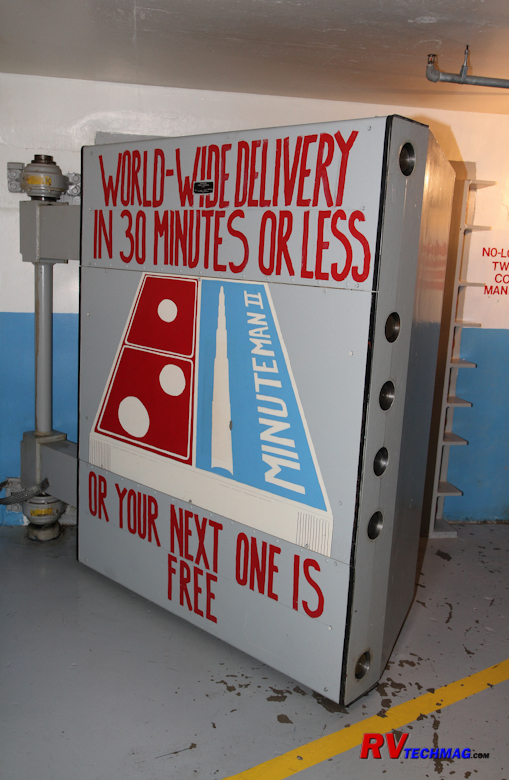
With extra time on their hands, crew members found creative ways of expressing themselves.
The Minuteman was a unique missile and those features helped in its deterrence role. We had many more missiles than the
Soviets so we had them outgunned. But the biggest advantage was the speed and state of readiness of the Minuteman. Typical liquid fueled rockets
require lots of maintenance and fuel needs to be purged and monitored so it takes time to get a liquid fueled ICBM ready for launch. The Minuteman
is a solid fueled missile so it can sit stagnant and unmanned for months at a time without any maintenance. In fact, the actual missile silos rarely
had any personnel present unless site maintenance was being performed. The Minuteman could be launched within 30 seconds should the command be given.
The Minuteman was also a faster missile and traveled at 15,000 MPH, which meant it could travel over the North Pole and reach its target in 30 minutes.
If we detected any inbound Soviet missiles we could easily get our birds off the ground with time to spare and reach their target before the incoming
missiles would arrive. All of these factors were well known by the Soviets so they knew it was a no-win situation should they decide to attack us.
As such, the Minuteman ended the Cold War without ever having to fire a shot.
|
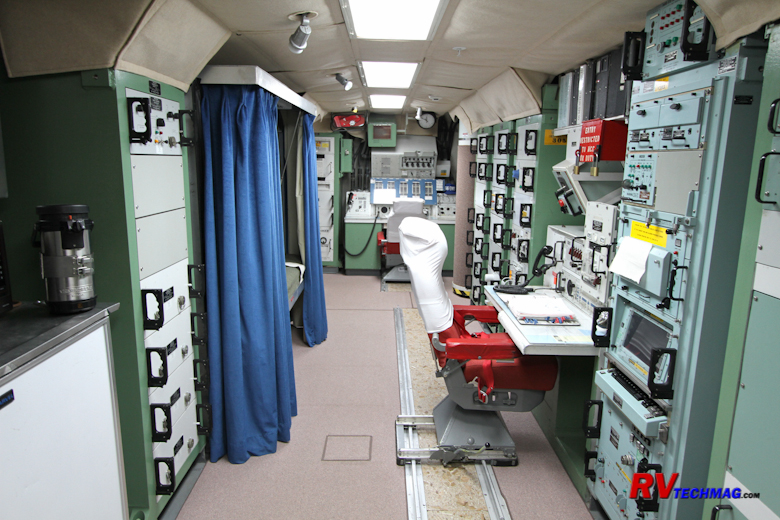
It took two men with separate keys to launch the missiles. Each station was 33' apart to prevent any one person from initiating a launch.
The launch control officers were seat belted into their positions. Sleeping bunks were provided for the officer who was not on active alert.
|
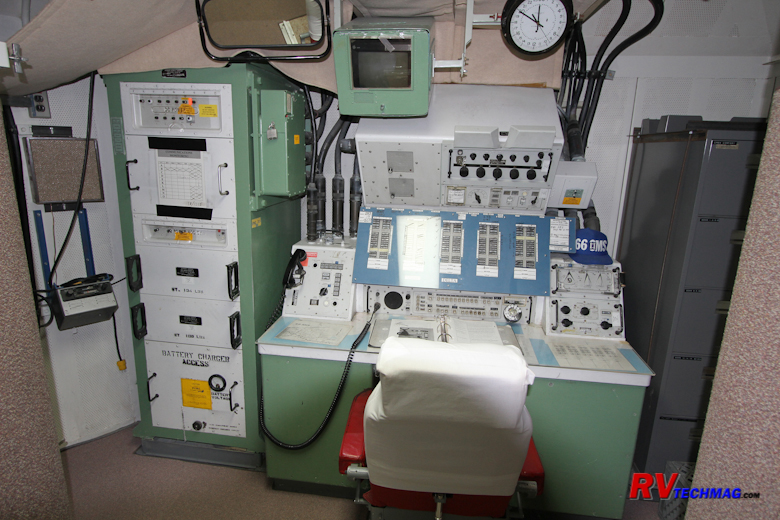
The senior launch control officer sat at this station to initiate the launch.
|
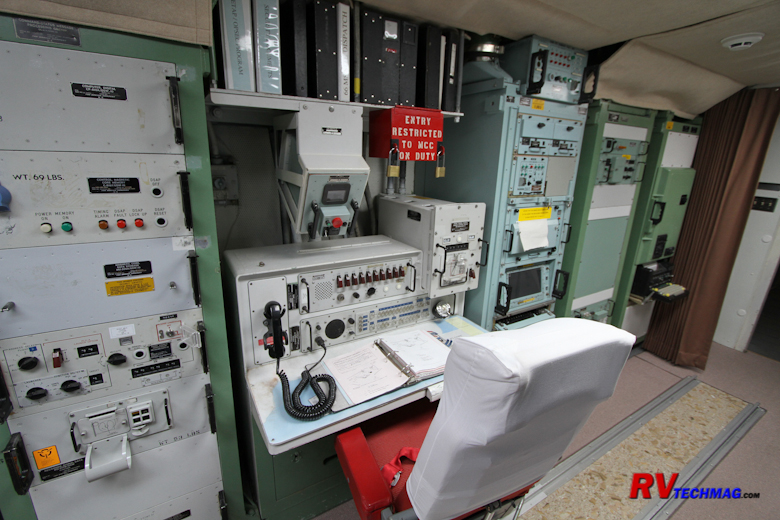
The assistant launch control officer's chair was mounted on sliding rails to allow access to the various components. Launch orders came
in via the equipment to his right and the safe on the far right held the launch codes and keys.
|
The tour into the launch control center was extremely interesting and the security measures required in place to prevent some
nut from starting a nuclear war were extensive and would fill a book so you'll just have to go take the tour to find all of that out. The technology
is all Cold War era with massive computer components that would probably be outdone by today's average laptop computer although they were built to be
rugged and endure some severe conditions and still function so maybe today's PCs could learn something from their older siblings.
The Missle Silo
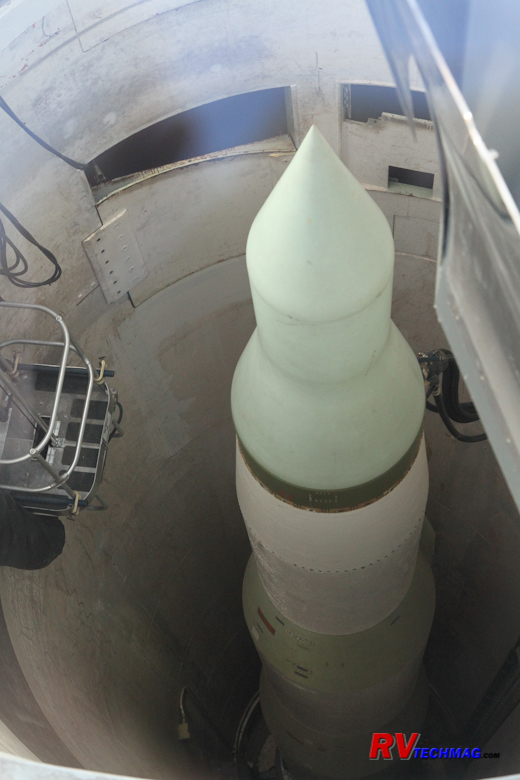
Shown here in its silo, the Minuteman II travels at 15,000 MPH and is capable of reaching its destination in 30 minutes or less.
The command control center controlled several missile launch sites. Each missile was placed in an underground silo and each
silo was spread out within a 20 mile radius to prevent clustering into one large target. After our tour of the Delta-01 Launch Control Facility we
headed off to visit the missile silo at Delta-09. Once we left the interstate exit we found small signs directing us to the missile site. Amazingly,
we had passed by this area on previous trips numerous times and never knew there was a missile silo nearby. The area was fenced in by a chain link fence
and various antenna arrays were present as well as a security monitoring system. This particular silo had the huge blast cover partially rolled back and
a glass enclosure placed over the silo so that visitors could look into the silo and see the missile, which was now inert and harmless. Access hatch
covers were visible as well as the hardware used to install the missile into the silo. A self guided tour was simplified by providing brochures at
the site as well as a point by point audio tour that was available over cell phones so, when visiting this site, be sure to bring your cell phone along.
When you're done visiting the missile site you may want to keep in mind that you are now only six miles away from Wall Drug.
|
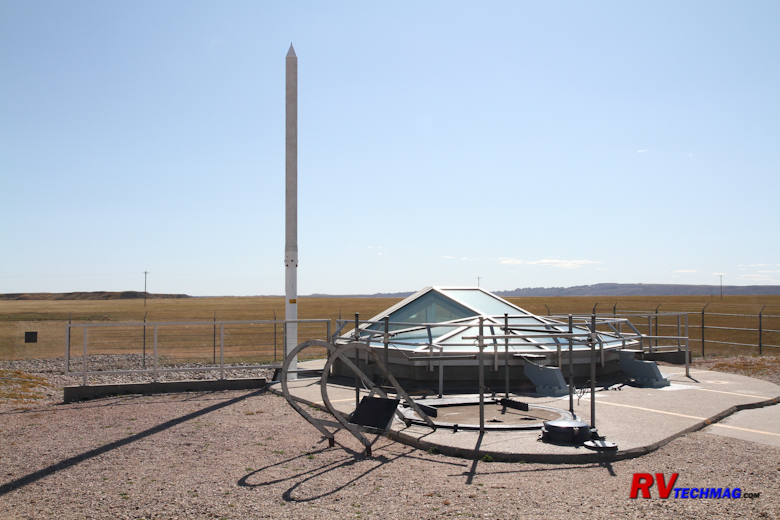
The 2' thick blast cover over the Minuteman II missile silo was partially rolled back and a glass cover installed to allow viewing of the
missile from above. The tall obelisk behind it is a motion detection system used by the security force to detect any intrusions.
|
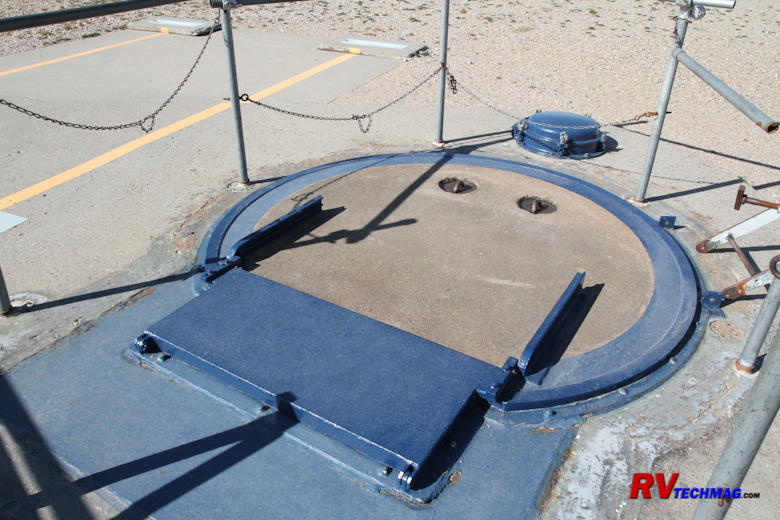
The heavy hatch cover requires hydraulic assist to open in order gain access to the silo. The small blue access cover adjacent to it
contains the keypads and key switches required to operate the main hatch cover.
|
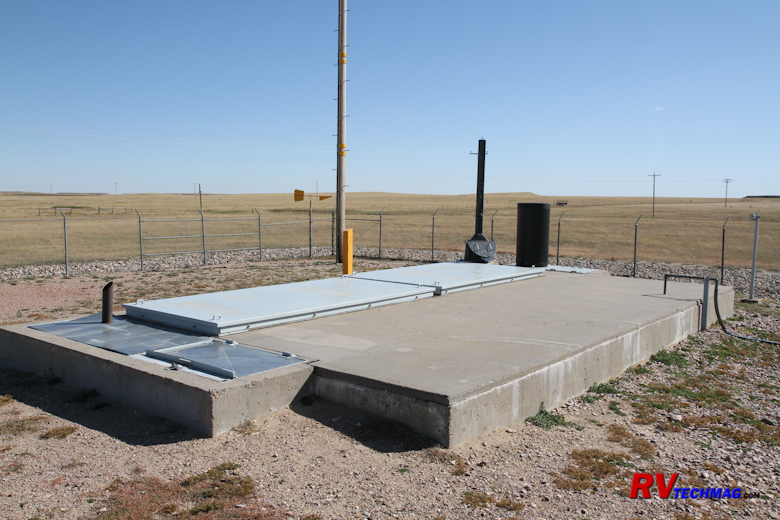
This slab covers an underground area that provides storage as well as an emergency generator set to provide electrical power to the site.
The burner on the corner of the slab was used to destroy any sensitive documents, such as access codes, which were changed on a daily basis.
|
In addition to the National Park Service missile sites, Ellsworth Air Force Base is near Rapid City, about an hour to the west
and features an excellent museum filled with aircraft as well as missiles and related equipment from the Cold War era. A launch control training
station has now been made part of the tour so if you can't make it to Delta-01 the mockup at Ellsworth is your next best bet. This is a really great
addition to the National Park Service and something quite unique that tells a great story of those times. If you still remember duck and cover
drills from your school days you'll truly appreciate this site. However, I'm sure that everyone will be fascinated with what they see.
Source
Return to Home Page
If you enjoyed this article be sure to recommend RVtechMag.com to your friends, like us on Facebook or Twitter
or subscribe to our RSS feed.



|

















